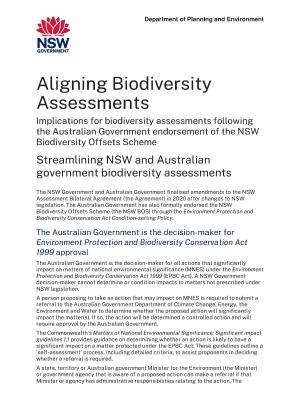Agreement with Australian Government
The NSW Assessment Bilateral Agreement (the Agreement) streamlines the assessment process for major projects that require both NSW and Australian Government environmental approvals. It is made under the Commonwealth's Environment Protection and Biodiversity Conservation Act 1999 (EPBC Act). Under the Agreement, the NSW Government assesses development applications on behalf of the Australian Government. The Australian Government remains the decision-maker for the EPBC Act approval, considering the assessment report prepared by NSW's Department of Climate Change, Energy, the Environment and Water.
On 24 March 2020, the NSW and Australian governments signed Amending Agreement No. 1 (the amending Agreement) which makes small amendments to the 2015 Agreement to respond to changes to NSW biodiversity and planning laws and improve the operation of the Agreement.
All new eligible major projects will now be assessed under the updated provisions of the Agreement. Projects that have been determined to be controlled actions prior to the amending Agreement being signed will continue under their existing arrangements.
Further information on the Agreement is available on the Department of Climate Change, Energy, the Environment and Water.
NSW Biodiversity Offsets Scheme is endorsed
The Assessment Bilateral Agreement only covers major projects (where the NSW Government is the consent authority) as it is an agreement between the NSW and Australian governments. To achieve streamlining benefits for all NSW proponents that use the Biodiversity Offsets Scheme (BOS) and need approval under the EPBC Act, the Australian Government has endorsed the BOS under the EPBC Act Condition-setting Policy. This means any NSW proponent who needs an EPBC Act approval can use the NSW BOS to assess and meet their biodiversity offset requirements.
The NSW and Australian governments agree that endorsement of the NSW BOS to avoid, minimise and offset biodiversity impacts on both NSW and Commonwealth listed entities provides for the best biodiversity and streamlining outcomes. The Australian Government supports the use of the Biodiversity Assessment Method as the underpinning methodology for calculating biodiversity credit requirements.
On 22 November 2019, NSW passed an amendment to the NSW Biodiversity Conservation Regulation 2017. The amendment aligns the BOS offset rules to Australian Government requirements. The NSW BOS has requirements for retiring like-for-like credits or funding conservation actions that directly benefit the species or community impacted, and these meet the Australian Government's offsetting requirements. The NSW BOS also allows for variation rules to be used after reasonable steps have been taken to source like-for-like credits. NSW amended the Biodiversity Conservation Regulation 2017 so the variation rules do not apply to offsets required for Commonwealth listed entities for controlled actions. If the NSW approval requires biodiversity offsets for NSW only listed entities, proponents will still be able to use the variation rules for these.
To meet offsets required for Commonwealth listed entities for controlled actions under the NSW BOS, proponents retain the ability to:
- retire biodiversity credits based on the like-for-like provisions in the Biodiversity Conservation Regulation 2017
- fund biodiversity conservation actions that are listed in the Ancillary rules: Biodiversity conservation actions and directly benefit the threatened entity impacted
- commit to deliver mine site ecological rehabilitation that creates the same ecological community or threatened species habitat
- pay into the Biodiversity Conservation Fund, noting it is the proponent's responsibility to notify the Biodiversity Conservation Trust that their payment is for a controlled action.
The Biodiversity Conservation Trust is required to meet the Commonwealth offset requirement component in a like-for-like manner. This is by retiring like-for-like credits, by funding conservation actions that are listed in the Ancillary rules: Biodiversity conservation actions and benefit the threatened entity impacted or by funding other conservation measures approved by the NSW Minister for Energy and Environment that directly benefit the entity impacted.
Where an action will impact on a Commonwealth listed entity that is not listed under NSW law, the Australian Government will set the assessment requirements and consent conditions for that entity. The NSW Government is investigating options for including all Commonwealth listed entities under the BOS to avoid separate offset requirements and achieve further streamlining benefits.
If you have an existing EPBC Act approval and would like to pay into the Biodiversity Conservation Fund to meet your offset requirement, you must have:
- a legal obligation to retire biodiversity credits under NSW law (generally via development consent conditions issued by an NSW consent authority under the Environmental Planning and Assessment Act 1979)
- an EPBC Act approval that was made on or after 24 March 2020, or if issued prior to this date, EPBC Act conditions of approval that allow for payment into a Commonwealth-endorsed Fund.
EPBC Act approval holders not eligible under the above criteria seeking to pay into the Biodiversity Conservation Fund as an alternative to existing offset obligations should contact the Department of Agriculture, Water and the Environment.
Further information on the streamlining of NSW and Australian Government biodiversity assessments is available in the Aligning Biodiversity Assessments factsheet.


